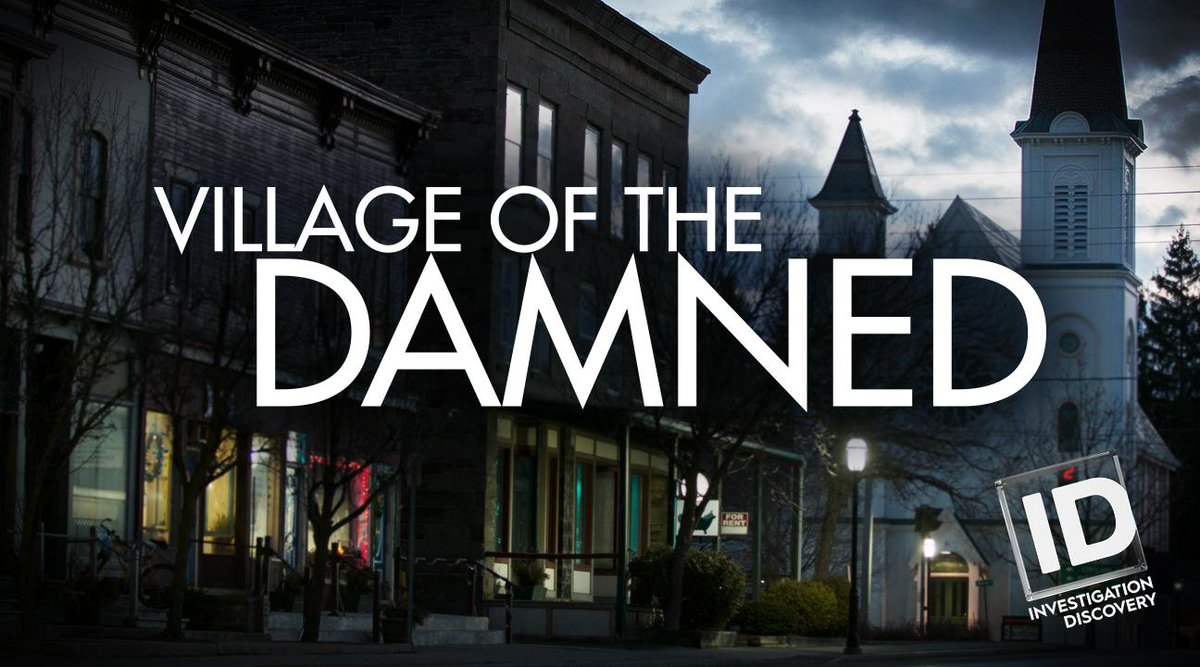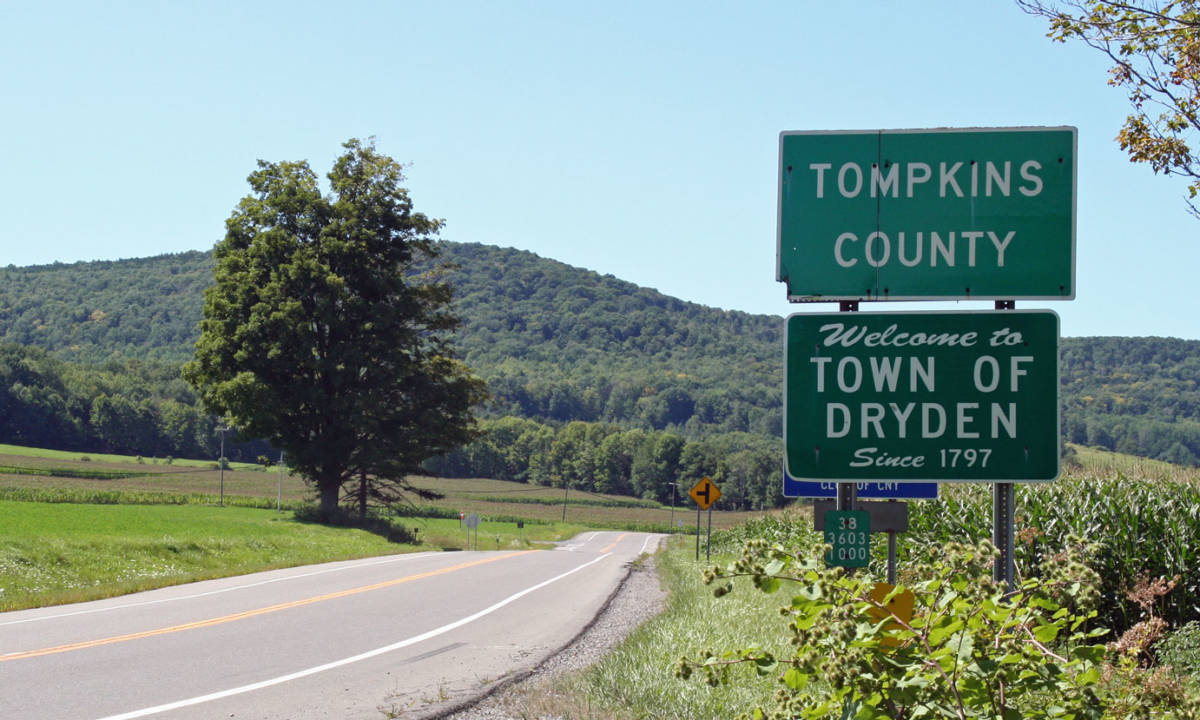As I mentioned in a news piece last week, Dryden, the town profiled in the new Investigation Discovery series Village of the Damned, is my hometown. Well, of sorts. My dad was in the military and was getting his PHD at Cornell when we lived in the area and we ended up staying longer than my family had planned. We moved to Dryden in August 1986, one day before my sixth birthday and a couple of weeks before first grade. We left in August 1995, just before I turned fifteen and a year before the last murders that this series profiles. Dryden is the place that I most associate with my childhood. So looking at the first episode of this documentary series, called “The Curse Begins,” was pretty interesting since I’m both from the place and an outsider.
I was pretty worried that the producers would try to set Dryden up as a kind of small town Mayberry to make the the murders seem that much more shocking. (How could it have happened here?) There was indeed a little bit of this, but not too much, and the stuff they did cite, like people not leaving their doors locked, rang true. The fact that the series was going to feature reenactments didn’t bode well, either. I started thinking of the cut-rate reenactments on shows like Unsolved Mysteries and the like, but the show is quite well acted, for what it is, though it’s probably good that they kept the dialogue in these reenactments to a minimum.
The show’s production value is pretty good for a TV show that I’m sure didn’t have a huge budget. It looks good or better than your typical Netflix documentary. Sometimes the cinematography is downright stunning, but this has a lot to do with the natural contrasts that the countryside surrounding Dryden produces in wintertime. Beautiful rolling hills and desolate snowdrifts combine to give one the sense of isolation, cruelty, and serenity all at the same time.
https://vimeo.com/243321090
Town leaders and survivors have started a Change.org petition asking that the series not air, which obviously hasn’t been successful, though it’s gotten about 3,500 signatures. The petition started before anyone had seen the series, and it prompted producer Stephen Dost to release an eight-minute clip to assuage fears that the series would be exploitative. It is exploitative, of course, but only to the extent that any of these true crime shows are. I can’t help but wonder if any of these 3,500 signers have seen a true crime or reality show or documentary themselves. Exploitation only seems to matter when it’s in your backyard, I guess.
Don’t get me wrong — I very much understand why this petition was started. I’m sure at least some of the survivors are re-traumatized every time these murders are brought up, as happens every now and again in local and national media. There was even a shitty Lifetime movie based on one of the murders. In addition,countless news articles have been written, including a piece that appeared in Spin and was later reprinted in the 2002 edition of Best American Crime Writing. But this series might be the most high-profile piece in any medium to feature the town.
https://www.youtube.com/watch?v=jnBr4CIZy58
This first episode concerns the murder of the Harris family in late December, 1989. Mother, father, daughter, and son were killed by a home invader. Their bodies were burned after they were shot to death. This is only the first time a high-profile murder will take place during Christmas time. Appropriate, then, that this show is airing at the same time. Could there be any more vicious contrast? Christmas in small town America, where people come together and celebrate family and community, and the most brutal of crimes forever associated with each other.
There were a lot of people who refused to be interviewed for this project. The entire thing, not just this first episode. And so there are only a handful of people who appear in this episode. Among them are the sister of Dodie Harris, the mother who was killed in the attack, and two state troopers who investigated the case. The two state troopers, John Beno and Linda Martin, were particularly shaken up over the incident. They’d never investigated a murder before, and probably never expected to, certainly not one of this magnitude.
The story begins on December 23rd, 1989. Dodie Harris opens the door after hearing a knock. The killer, riding a bicycle, claims that his tire is blown. Harris lets the man into her house because this is a place where people don’t lock their doors and they trust just about everyone. In my little neighborhood, even at six years old, I was allowed to wander unsupervised around the subdivision. If we were out of our parents’ eyesight, we were never far from neighbors, who were looking out for us, as well as any other kids in the neighborhood. So it’s no surprise at all that Harris immediately opened the door and let the killer inside her house.

This kind of trust in one’s neighbors is why trooper John Beno doubts that anything much but an alarm malfunction is going on when he gets called to the Harris’s house, and it also explains why he is so goddamn freaked out about the whole thing. The last thing on his mind would have been murder, especially something so brutal.
The exact events of the evening of the home invasion aren’t known, but what is definite is that the Harris daughter was tied up and tortured before she and her family were shot to death and had their bodies burned. Even worse, Beno and his team can’t even find a single fingerprint. The killer was a professional house cleaner and knew how to cover his tracks. The killer probably thought he had committed the perfect crime.
Clues begin to emerge over the course of a few weeks. The theory becomes that the killer, the man who rode to the Harris house on his bicycle, was attracted to the location because of a small gift shop that was on the property, thinking he could rob the till. Eventually the guy is identified as Michael Kinge after it’s found that he and his mother went on a shopping spree with the Harris’s credit cards. They bought…fucking Christmas presents. Jesus Christ.
Finally, troopers raid the Kinge house and kill Michael when he pulls a shotgun on them. But the case isn’t over. There’s still the matter of Shirley Kinge, Michael’s mother. Evidence emerges that she was in the house with her son after a fingerprint is discovered on the gas can used to set fire to the bodies. She went to prison, but she was later let out when it was discovered that trooper David Harding fabricated the evidence. This proved two things: Shirley was never at the house, and even the “good guys” in small town America can have a dark side.

But the episode isn’t over yet. Just as the investigation starts to wind down and state troopers close in on Michael Kinge, two-year-old Aliza May Bush goes missing. The Harris killer hasn’t been brought in yet, so people start freaking out, understandably, thinking that perhaps the same killer is behind the disappearance of little Aliza. The show cuts between these two cases for a while, an editing technique that mirrors how chaotic it all must have felt watching all of this unfold. Things would get more confusing when it’s revealed that the two incidents don’t have anything in common at all. That they overlap is merely a coincidence. For a town that has rarely been affected by such tragedy, to have two happen at the same time had to be nerve wracking. What happened to little Aliza? The show leaves us on this insane cliffhanger.
This is certainly compelling stuff, even if you have no personal connection to Dryden, though if you do it will certainly seem surreal seeing your tiny town once again profiled by the national media. But history is bigger than any one person, than any one town. Alicia Alexander, one of the residents interviewed for this episode sums the whole thing up pretty succinctly when she says that we’re fascinated by incidents like this because they’re “absolutely out of bounds of what we perceive as human nature.” Indeed. And as a friend of mine who lived in Dryden said recently, “Nobody owns tragedy.” That’s true in this case as much as any other. Dryden’s tragedies are America’s tragedies, and there’s a lot we can learn by studying them.
Some of the coverage you find on Cultured Vultures contains affiliate links, which provide us with small commissions based on purchases made from visiting our site. We cover gaming news, movie reviews, wrestling and much more.



